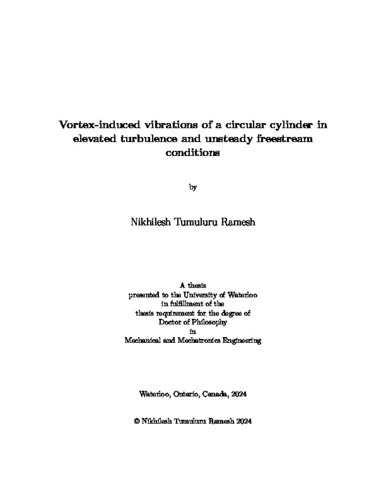| dc.description.abstract | This thesis presents the results of a series of experimental investigations focused on exploring one degree of freedom (1-DOF) vortex-induced vibrations (VIV) of a rigid, circular cylinder in two practical flow conditions: elevated freestream turbulence (eFST) and unsteady incoming flow. Elevated FST was generated by placing a turbulence grid upstream of the VIV setup. Unsteady freestream conditions were achieved by ramping the freestream velocity in sigmoidal profiles between end states corresponding to adjacent VIV response branches. A key novelty of the present work is the simultaneous consideration of the structure and wake dynamics to better elucidate the physical mechanisms at play.
First, VIV in moderate levels of eFST (𝑇𝑢 = 2.7%) were examined. Notable deviations of both structure and wake behavior are observed towards the end of the lower response branch. In particular, an earlier onset of desynchronization is observed in the presence of eFST. Conversely, minimal changes are observed within the initial and upper response branches. The underlying mechanisms resulting in the general robustness of VIV to eFST were investigated by comparing eFST effects on the wake of a stationary cylinder and an elastically-mounted cylinder vibrating with minor oscillation amplitudes (less than 1% of cylinder diameter). For stationary cylinders, eFST promotes transition in the separated shear layers, precipitating several changes to the near wake characteristics. Conversely, the shear layers in the VIV cases are desensitized to the perturbations of eFST. This change in shear layer behavior in VIV is linked to the coupling between the fluid and cylinder, featuring
small perturbations to the shear layer induced by cylinder oscillations. The fluid-structure coupling is evidenced by a slight modification of the von Kármán shedding frequency in the wake and the emergence of this modified shedding frequency in the cylinder displacement spectra in addition to the structure’s natural frequency. Additionally, analysis of the wake
in the lower branch revealed subtle changes to the vortex dynamics in the presence of eFST that are reflective of the system transitioning to a premature desynchronized state. VIV in unsteady flows typically feature transient changes to the structural and wake dynamics. Transient dynamics are encountered when the energy gained by the structure from the fluid is not balanced by the energy lost to damping, leading to a change in the state of the system. Transient VIV dynamics are also encountered in steady flow conditions when the system experiences changes to its structural properties. Thus, owing to fewer experimental challenges, transient VIV was first studied in steady flow by releasing a cylinder from rest and observing its transient progression until it converges on quasi-steady oscillations. The results indicate notably different dynamics across the response branches, including a distinct overshoot of oscillation amplitudes for reduced velocities in the initial branch and a
gradual increase in oscillation amplitudes, with the envelopes resembling sigmoidal curves, for reduced velocities in the upper and lower branches. The oscillation amplitude growth rate was found to decay with increasing reduced velocities. This is associated with the differences in the forcing characteristics (and consequently the energy transfer between the
fluid and structure) on the cylinder, with the phase difference between forcing and cylinder displacement playing a prominent role. Analysis of the wake revealed the different coherent structures encountered as the system transitions from initial von Kármán shedding to the final vortex shedding patterns characteristic to each branch. Additionally, quantitative
wake analysis revealed a close relationship between the forcing phase difference and the timing of vortex shedding with respect to the oscillation cycle. Finally, key insights are gained into the onset of lock-in, featuring distinct changes to the forcing characteristics that are associated with a modification of the vortex shedding mechanism. Specifically,
cylinder oscillation promotes the deflection and mutual interaction of oppositely-signed shear layers, resulting in a progressive disruption of the von Kármán shedding mechanism. The final set of experiments considered transient VIV in unsteady incoming flow conditions. Two distinct freestream accelerations were considered including a “fast ramp”, where the
change in freestream velocity occurs within 45 cylinder oscillation cycles, and a “slow ramp” where the freestream velocity change is within 900 oscillation cycles. A total of six cases were considered that correspond to transitions between adjacent response branches. Analysis of the structure and wake response for the fast ramp indicate a relatively rapid
initial response to the changing freestream velocity (within 20 oscillation cycles) for all cases, however, the transient progression between the two end states varies significantly between the different cases considered. Similar to the findings from the release from rest experiments, the transient dynamics were closely related to the energy transfer mechanisms
between the fluid and structure, with significant influence from the phase difference between forcing and displacement. The slowest rates of oscillation amplitude change were observed at larger reduced velocities near the lower branch, while the largest rates of amplitude change occurred near the initial-upper branch transition. Overall, the transient dynamics
for the fast ramp deviated significantly from the expected quasi-steady response, with the slowest transient exceeding six times the expected quasi-steady response based on the instantaneous freestream velocity. Analysis of the slow ramp cases revealed the transient dynamics approaching quasi-steady behavior, while the nature of the responses remained
similar to those from the fast ramp. Comparisons between the present results and those from previous studies suggest a significant dependence of system behavior on the mass ratio. In particular, an approximately inverse relationship was found between the mass ratio and the mean freestream acceleration required to elicit quasi-steady behavior. | en |

